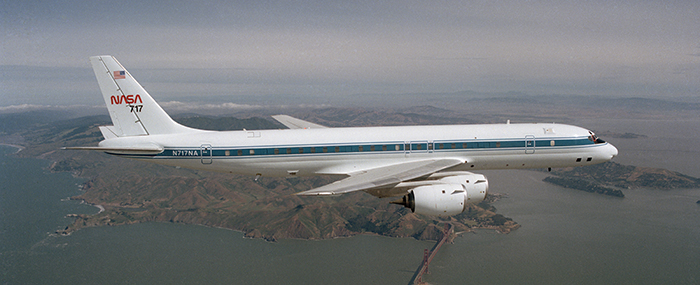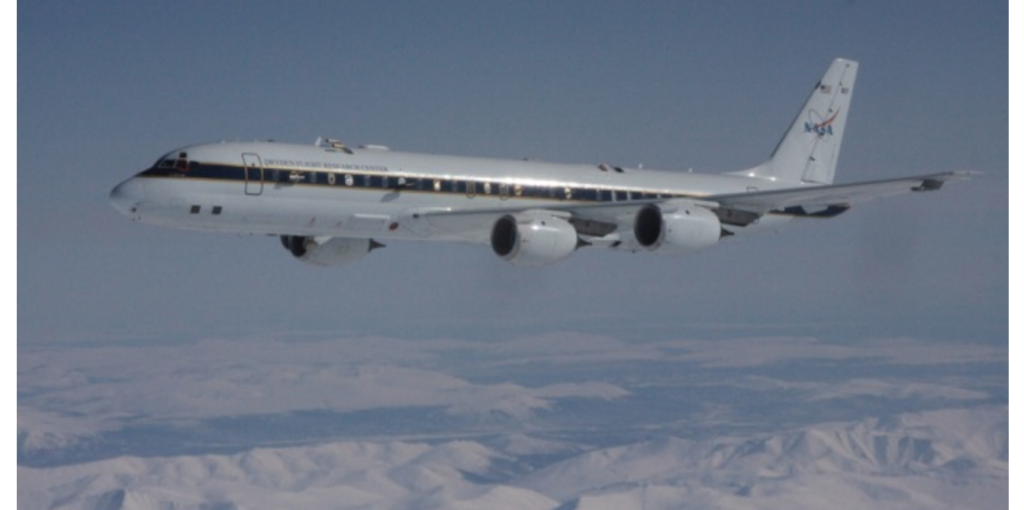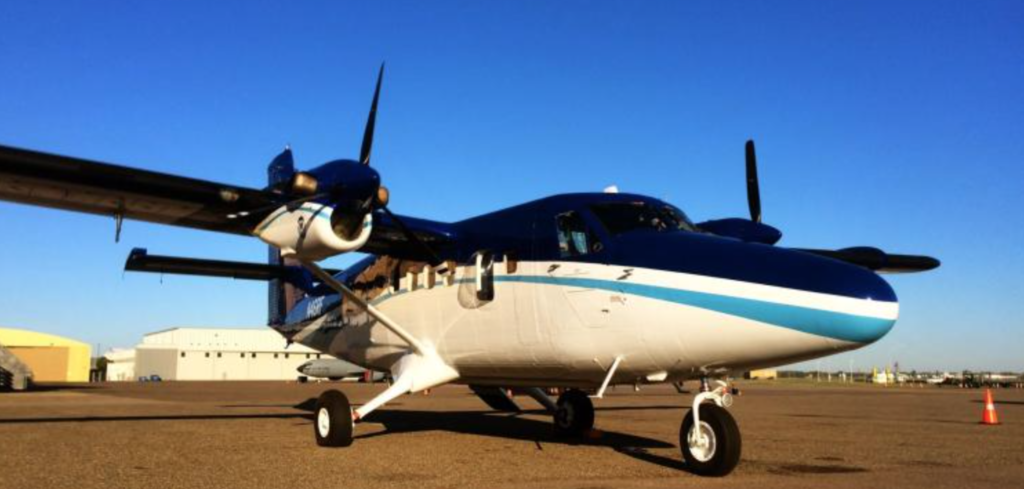Carsten Warneke with NOAA flies through wildfire columns in a converted DC-8. On purpose. As reported by Devin Farmiloe in SLATE Magazine, Warneke is a research physicist with the National Oceanic and Atmospheric Administration who investigates wildfires and their effects on air quality. He collects for analysis air samples over a live wildfire and its smoke columns, including in a DC-8 over the 2019 Williams Flats Fire, which burned more than 5,000 acres in northeastern Washington.

“We knew what was coming when we saw the monster of a plume,” remembers Warneke. “It was so much bigger than anything else we had seen. But we are scientists, so we were geeking out. The excitement for measuring such a large plume trumped everything.”
He said they decided to measure as close to the fire as possible to get emissions, and then follow the plume downwind to see how those emissions changed. The plume was 20,000 to 25,000 feet, so they decided to fly it at about 1,000 feet below the top of the plume. “You can’t fly directly over the fire, because the updraft is so large it would be extremely dangerous,” he explained. “In a fire that size, there are pieces of branches and stuff going a couple thousand feet into the air, so we had to go higher up.”
There is about three years of planning that goes into these missions, and one of the last stages is to decide where the emissions measurement instruments are going to be secured in the aircraft, what its weight is, and whether the aircraft is able to carry out the campaign. An aircraft over a fire, Warneke says, “is about the worst environment you want to put your high-performing atmospheric instruments in. These instruments are like the Formula One race cars of atmospheric chemistry.”
Each one weighs a few hundred pounds and is about the size of a washer/dryer combo. “They have a lot going on,” explains Warneke, “a monitor, weird pumps, vacuum fittings, and so on. The window next to each of these instruments has been replaced with an aluminum plate that has a little wing on the outside of it, to be more aerodynamic and reduce drag. Within that little wing, we stick the tube to collect air samples. There is a first-class passenger seat next to each instrument for the scientist in charge of making it run properly.”
Warneke remembers in particular one FIREX flight through smoke in Montana, over a grass fire that had already been contained. Smoke was still hanging on top, but the air was clear beneath it.
“There was still a little residual heat,” he says, “and we flew through it at maybe 10,000 feet. As we went through the smoke, the updraft was still so strong that the plane jumped up 100 meters within a couple of seconds. At that moment, I was standing in the cabin, and it bumped me up and I levitated for a second before we bumped down on the other side. At that moment, everyone went silent over the headsets, then a minute later the pilot said, ‘If we do this again, let’s make sure we have seatbelt signs on.'”
“We did the FIREX campaign in 2019, which was one of the lowest fire years we have had in a decade now, but wildfires have been recurring for years and years, and the impacts will stay with us for decades to come,” says Ca*************@no**.gov">Warneke. “Researching wildfires will continue to be important to our lab, especially since our largest air-quality-exceedance days happen with wildfire smoke.”

The Fire Influence on Regional to Global Environments and Air Quality (FIREX-AQ) campaign was a NOAA/NASA interagency intensive study of North American fires to understand the integrated impact of fire emissions on the tropospheric chemistry and composition and to assess the satellite’s capability for detecting fires and estimating fire emissions.
The overarching goal of FIREX-AQ was to provide measurements of trace gas and aerosol emissions for wildfires and prescribed fires in great detail, relate them to fuel and fire conditions at the point of emission, characterize the conditions relating to plume rise, and follow plumes downwind to understand chemical transformation and air quality impacts.

Completed during summer 2019, FIREX-AQ combined instrumented aircraft, satellites, and ground-based instrumentation. Detailed fire plume sampling was carried out by the NASA DC-8 aircraft, which had a comprehensive instrument payload capable of measuring over 200 trace gas species, as well as aerosol microphysical, optical, and chemical properties.
The DC-8 completed 23 science flights, including 15 flights from Boise and 8 flights from Salina, Kansas. NASA’s ER-2 completed 11 flights, partially in support of the FIREX-AQ effort. The ER-2 payload was made up of 8 satellite analog instruments and provided critical fire information, including fire temperature, fire plume heights, and vegetation/soil albedo information. NOAA provided the NOAA-CHEM Twin Otter and the NOAA-MET Twin Otter aircraft to measure chemical processing in the lofted plumes of Western wildfires.

The NOAA-CHEM Twin Otter focused on nighttime plume chemistry, from which data is archived at the NASA Atmospheric Science Data Center (ASDC). The NOAA-MET Twin Otter collected measurements of air movements at fire boundaries with the goal of understanding the local weather impacts of fires and the movement patterns of fires. Additionally, a ground-based station in McCall and several mobile laboratories provided in-situ measurements of aerosol microphysical and optical properties, aerosol chemical compositions, and trace gas species.
For more information on the Airborne Multi-angle SpectroPolarimetric Imager (AirMSPI) data collected during FIREX-AQ, see: AirMSPI FIREX-AQ Terrain-Projected Georegistered Radiance Product.

It’s interesting about not flying directly over the fire because of the updrafts. In 2003 I was working with the Southeast Airizona type 2 team on the Aspen Fire and it was putting up a huge column. Jeff Pechura was the Air attack. he called Coronado dispatch and asked them to call the Air Force at Davis-Monthan and tell them to stop those F16s that were flying through the column. Later he said there was two F16s. They would fly into the column and come out inverted on the other side.
from 2021:
Air Force proposes lowering jet altitudes
Many people in the SE corner of Oregon thought they should have been raised …
When I worked on the Heppner Ranger District in Eastern Oregon in the 1980s, C130s would fly close by Madison Butte Lookout below ridge top level. She said she hoped they could see where they were going.
One time a Colonel from the Army called me to let me know they were going to do a special operations training on the district at Long meadow and told me the time it would occur . I asked if I could come watch. He said I could but probably wouldn’t even see them. The whole operation would last only four minutes.
A C130 would fly in at tree top level and when it was over the meadow drop a load of Paratroopers. One minute later several helicopters would land, pick up the paratroopers and take off. The whole operation would last only four minutes.
I talked to my three engine crews the morning of the operation and told them the time to meet me at Long Meadow. We saw the whole thing happen as planned., except one Paratrooper hung up in a pine tree. He climbed down the but left his parachute in the tree. One of the engine crew members said “I’m gon’a go get that parachute. I said “No You’re not!”
As an electrical engineer who loves instrumentation and data collection, who used to work in aviation and loves wildland firefighting, working on these missions sounds like an absolute dream.